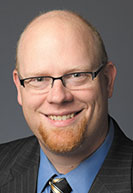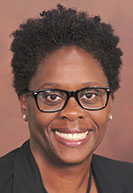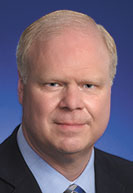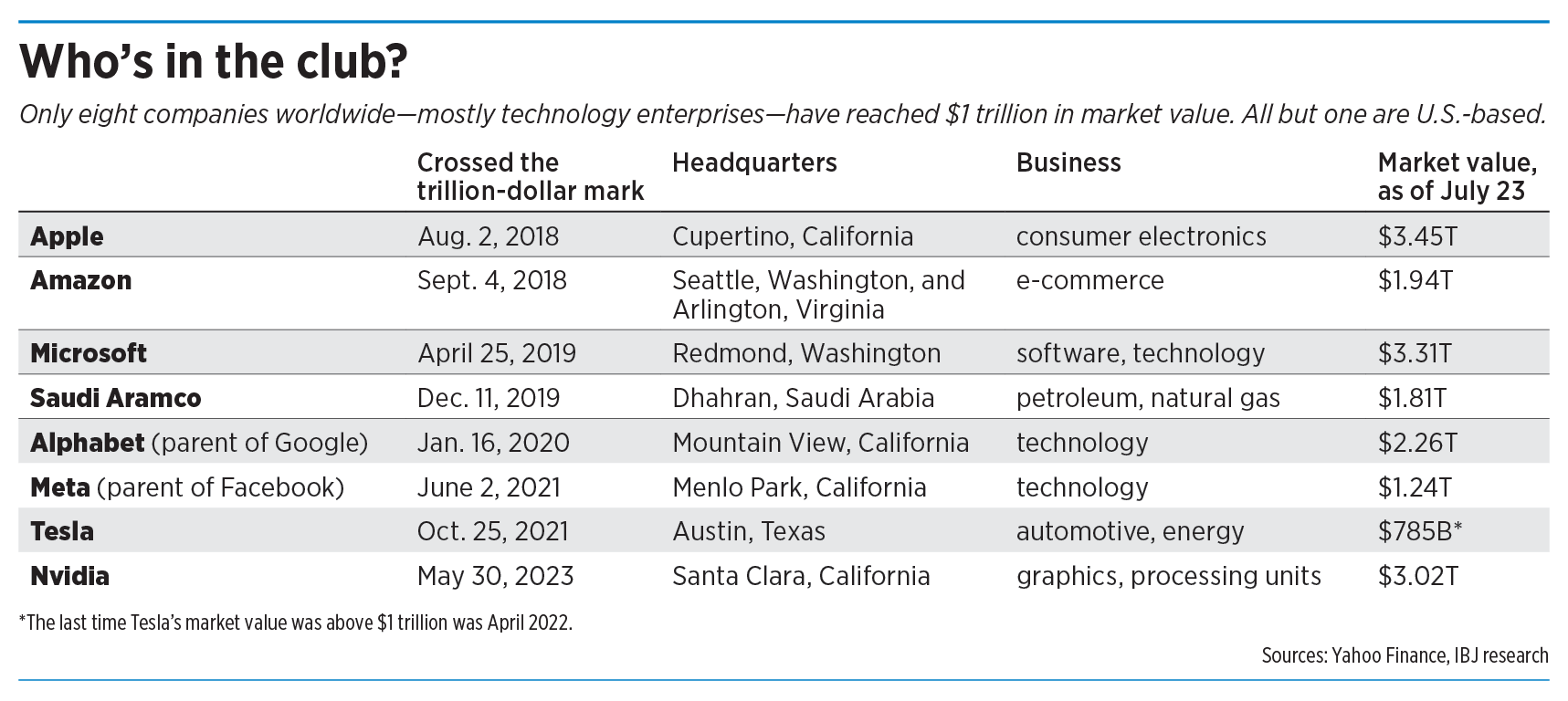Subscriber Benefit
As a subscriber you can listen to articles at work, in the car, or while you work out. Subscribe NowIt might be called the most exclusive club in the world.
Just seven companies on the planet are worth $1 trillion or more—mostly Big Tech names such as Apple, Amazon and Microsoft. Passing the $1 trillion mark in market value brings instant distinction and corporate stardom.
These days, the spotlight is turning to Indianapolis-based Eli Lilly and Co. as the next possible member of the so-called “Trillion-Dollar Club,” based on the drugmaker’s climbing stock price and the swelling demand for its treatments for diabetes, obesity and other diseases.
Lilly’s market capitalization—the price of a share of stock times the number of outstanding shares—has soared 88% in the past year to an all-time high of $898 billion on July 16, putting the company within striking distance of the $1 trillion mark. Just last August, Lilly’s market value stood at $518 billion.
Many analysts and corporate finance experts say they are keeping an eye on Lilly as it flirts with the $1 trillion mark.

“Eli Lilly approaching $1 trillion market cap is a huge deal, not because of the number itself but because it signifies that Lilly is a top 10 company globally, joining the likes of Apple, Microsoft, Amazon, etc.,” said Alex Boquist, clinical associate professor of management at Purdue University and a former financial analyst at Goldman Sachs & Co. “It’s also significant to note that Lilly has passed all other pharmaceutical corporations—such as Pfizer, Merck and Johnson & Johnson—all of which had a bigger market cap than Lilly 20 years ago.”
Indeed, Lilly is more valuable than any other health care company in the world—even larger enterprises with much higher revenue. Drugmaker Merck, for example, had revenue last year of $60.1 billion, nearly twice that of Lilly’s $34.1 billion. But its market value was just $315 billion, or less than half of Lilly’s, signifying that investors had more faith in the Indianapolis company and were willing to bid up the price of its stock.
Lilly’s stock and market value have settled down a bit in recent days, putting the company’s value at about $834 billion in trading on Tuesday. Like most stocks, Lilly shares fluctuate from hour to hour and from day to day, making it impossible to predict when the company will cross the $1 trillion mark.
But observers say the moment, when it arrives, will be a significant milestone.

“Reaching a market cap of $1 trillion is a strong validation from investors regarding Lilly’s business model, growth prospects and strategic initiatives,” said Sheryl-Ann K. Stephen, professor of finance at Butler University. “It signals that the market has a high level of confidence in Lilly’s future.”
It also shows how far Lilly has come in just the past decade or so, when it was struggling and was whispered about as a potential takeover target. Today, the company’s market value is more than 20 times its value in 2010, $40 billion, when Lilly was facing a patent cliff of its leading drugs and its pipeline of new drugs was sputtering.
Today, the picture couldn’t be more different. Lilly has turned out more than 20 drugs in the past decade, including diabetes treatment Mounjaro, weight loss treatment Zepbound, and Alzheimer’s disease treatment Kisunla.
Mounjaro and Zepbound, which are known as GLP-1 drugs, are even starting to yield interesting clinical results for other diseases. A phase 3 clinical trial published in June in The New England Journal of Medicine found that tirzepatide, the active ingredient in both drugs, can reduce the severity of obstructive sleep apnea symptoms in adults with obesity by almost two-thirds.

“There are people who believe even beyond obesity, it’s going to be used in other applications to essentially curb sleep apnea and some other collateral diseases,” said Roger Lee, director of research at Columbus-based investment adviser Kirr Marbach & Co. “That could open huge markets.”
Some of the drugs are in such high demand that Lilly has had trouble making enough and getting them to pharmacies.
In April, the company reported that “exceptionally strong demand” for Mounjaro and Zepbound helped push first-quarter profit up 67%. But the company warned that it expected tight supplies of both drugs to continue.
Doctors, patients and pharmacies have reported a widespread shortage of Mounjaro and Zepbound in recent months. In response, Lilly said in May it would invest an additional $5.3 billion in its new, 600-acre manufacturing complex in Boone County, where it broke ground just a year ago, pushing the company’s total investment at the site to $9 billion.
CEO David Ricks said huge investment would almost triple the site’s manufacturing capacity, and he is pressing for speed to get the company’s new manufacturing sites worldwide up and running as quickly as possible to meet unprecedented consumer demand.
“It takes three or four years to build these sites,” he said at a press conference on May 24. “I don’t have three or four years. I need to do it in two or three, and we need to break the records on speed.”
Great expectations
Wall Street expects Mounjaro to bring in $11.1 billion in sales this year, growing more than 115% year over year, according to Investor’s Business Daily. Zepbound is projected to generate $4.5 billion in sales. In 2029, analysts expect the two drugs to bring in a whopping $29.95 billion and $20.33 billion in sales, respectively, the newspaper said.
Some individual analysts are even more bullish, pointing to the huge demand for Lilly’s so-called “incretin” drugs, a class of drugs that include Mounjaro and Zepbound and mimic the effects of natural hormones to help lower blood-sugar levels and lose weight.
“While [Lilly] shares trade at a significant premium to peers, we see unprecedented growth for Lilly over the next decade with the company’s incretin franchise reaching $68 billion by 2030 and continuing to grow from there”—or twice Lilly’s total revenue last year, J.P. Morgan analyst Chris Schott wrote in a research note on July 22.
He has an “overweight” rating on the stock and predicts that shares will reach $1,000 by Dec. 25. Steve Scala at TD Cowen is even more bullish, with a price target of $1,050. Lilly shares closed at $878.29 on Tuesday.
Lilly shares are trading at a whopping 62 times earnings per share, much higher than the S&P’s current 27.
But some analysts say Lilly’s stock price runup is overhyped. Goldman Sachs has a price target of $812, while Deutsche Bank is predicting $725. (A price target is the price an analyst thinks a stock will reach within 52 weeks, based on earnings forecasts, valuation multiples and other factors.)

“Regardless of the price estimates, Eli Lilly and Co. has enjoyed and will continue to experience tremendous revenue growth, fueled by a product pipeline that is the envy of the entire pharmaceutical industry,” said Matthew Will, associate professor of finance at the University of Indianapolis.
Of the 22 analysts who follow Lilly, 13 have a “buy” or “strong buy” rating, eight have “hold” ratings, and one has an “underperform” (or “weak hold”) rating. The company will report second-quarter earnings on Aug. 8.
Lilly declined to make a senior leader available for an interview. In a brief statement to IBJ, the drugmaker avoided talking about its market value, instead redirecting the conversation to the needs of patients.
“When we talk about growth at Lilly, we focus on creating new and better medicines. Our scientific breakthroughs and investments help refuel our pipeline so that we can serve millions of patients worldwide with unmet needs,” the company said.
Hometown benefits
Lilly’s soaring fortunes seem to be good news for Indianapolis, where the company started 148 years ago as “Eli Lilly, Chemist,” named after its founder, Col. Eli Lilly.
Lilly has 36,000 employees worldwide, including about 10,500 in Indiana, who can count on stability. Its top leaders, including Ricks, have pledged to keep the company independent and based in Indianapolis.
Lilly’s success is also creating riches for its shareholders, who have seen the stock value increase more than 1,200% in the past decade.
The company’s largest shareholder is the Lilly Endowment, one of the largest charitable foundations in the country. Members of the Lilly family set up the endowment in 1937 with gifts of stock.
Over the past decade, the endowment’s net assets, which are almost all in Lilly stock, have grown from $7.7 billion in 2013 to $62.2 billion at the end of 2023.
The foundation makes grants to arts, education, religious and community organizations in Indiana and beyond. In 2023, the endowment paid $1.5 billion in grants and approved an additional $1.7 billion to 1,081 grantees.
So as Lilly does well, so does the Lilly Endowment and organizations in Indiana that win its grant money. “It’s great that we have a company of this caliber in our state,” said Boquist of Purdue University.
Some take the sentiment even further.
“A trillion-dollar market cap means Lilly has significant economic influence,” said Stephen of Butler University. “The company plays a crucial role in the global economy, impacting health care, employment and even policymaking. The high market cap can also give Lilly a huge advantage in mergers and acquisitions, partnerships and negotiations with stakeholders.”
The trillion-dollar mark is a recent milestone in corporate America. Apple, the consumer electronics company and maker of the iPhone, was the first company to cross the trillion-dollar mark in market value in 2018 and has since also crossed $2 trillion and $3 trillion marks, with a market value today of $3.45 trillion.
Behind it, over the next few years, were Amazon, Microsoft, Saudi Aramco (the only non-American company on the list), Alphabet (parent of Google), Meta (parent of Facebook), Tesla and Nvidia.
Today, those American companies are widely known as the “Magnificent Seven”—a term coined by Michael Hartnett, chief investment strategist at Bank of America Global Research, who introduced it in a 2023 research note.
“That term quickly caught fire on Wall Street as those stocks raced higher, pushing the S&P 500 index to jump 24% last year as interest rates hovered at a 23-year high, geopolitical turmoil swirled and investors dealt with a regional banking crisis,” CNN reported in February.
Of the Magnificent Seven companies, six have managed to keep their market values above the $1 trillion level. Tesla fell below that level in spring 2022; its market cap is now $785 billion.
The next three companies likely to join the “magnificent” group are Lilly, conglomerate Berkshire Hathaway and tech company Broadcom, according to a story published July 2 by Bankrate, a personal finance company based in New York City. In fact, the story predicts Lilly will be the first to cross the $1 trillion mark and will do so within four months.
“Could Eli Lilly Be the Next to Join the Trillion-Dollar Club?” teased a May 29 headline in Motley Fool, an investor website.
“This company isn’t a technology player,” the story read. “Instead, it’s in the business of pharmaceuticals, an area generally associated more with slow and steady earnings progression rather than explosive growth.
“Eli Lilly in recent times, though, has looked more like a high-growth company, generating double-digit quarterly earnings growth thanks to new medicines that have taken the world by storm.”•
Please enable JavaScript to view this content.

